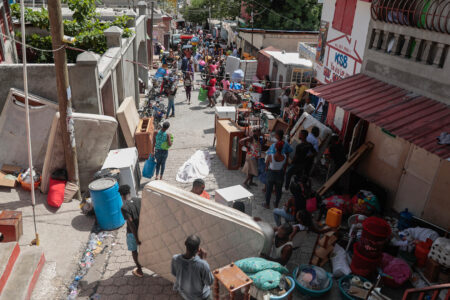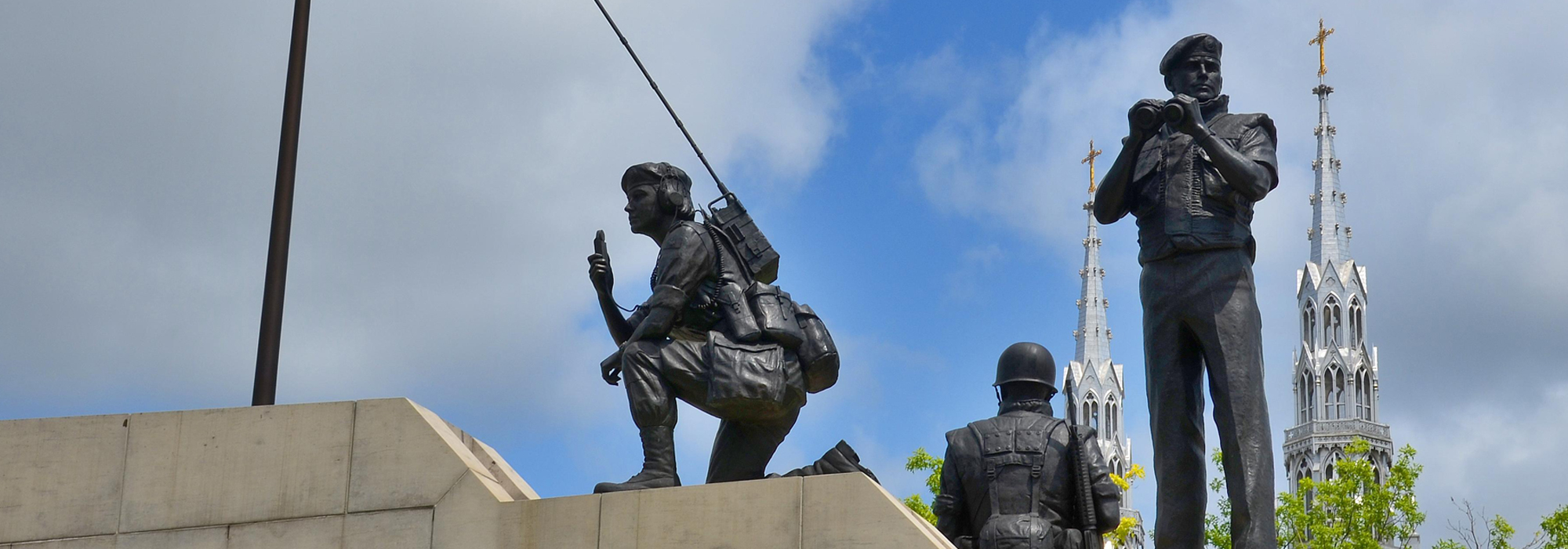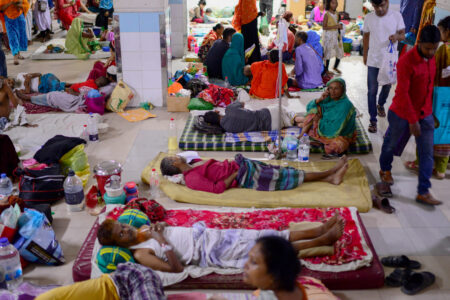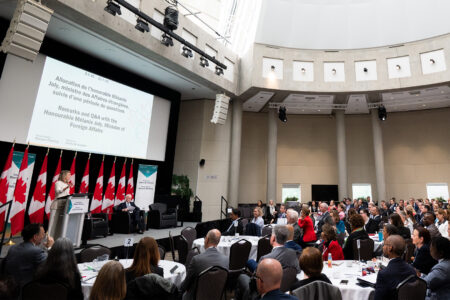
It’s time for Canada to re-engage in United Nations peace operations. Defence Minister Harjit Sajjan is visiting five African countries this month, examining where might make the best sense for a major new mission. But today’s peace operations are fraught with larger overall challenges for the UN, three of them identified by Prime Minister Justin Trudeau when he laid out a new course for Canada: prevention of armed conflict, rapid deployment, and appropriate training for UN peace operations. With a few bold steps in each direction, we might also be able to help build a better foundation for the UN and improve our prospects for sustainable common security.
Since 2008, the incidence of violent conflict has tripled. The Global Peace Index reported the cost of war in 2015, after a decade of declining peace, to be a staggering US$13.6 trillion. As if extremism and terrorism were not enough, there are growing concerns of another Cold War, and threat multipliers such as climate change, resource depletion, growing inequality and militarization. With 16 peacekeeping operations already straining the UN system at a cost of US$8.2 billion, the near-term forecast includes more, with Syria, Yemen and Libya looming large.
Meanwhile, the UN’s challenges haven’t diminished. Rather than rapid deployment, routine delays are the norm. It frequently takes six months to a year or more to deploy a new operation. Many missions still remain under the strength required. With slow responses, conflicts tend to escalate and spread, and then they demand larger and longer operations at far higher costs.
That we need a more preventative approach to sustain peace may be increasingly accepted, but our available means remain inappropriate. As Youssef Mahmoud writes, “the three 2015 UN global peace and security reviews” indicate “that the political instruments, tools, and mechanisms the world body deploys to address violent conflict all attest to the failure of early prevention.” It’s time to encourage a wider shift from war-fighting to providing prompt help and useful services.
Insufficient national training for UN operations continues to compound problems, and often results in risks to vulnerable civilians, peacekeepers and the reputation of the UN itself. Without sufficient preparation, screening and selection, a handful of UN contingents are jeopardizing the laudable efforts and reputation of the 120,000 UN peacekeepers working to improve conditions.
In May, the president of the UN General Assembly conceded the obvious: 70 years after its founding, the organization is still not equipped to meet its primary objective — to save succeeding generations from the scourge of war.
There are several ways that Canada can contribute to the improvement and reform of the UN’s peace operations, drawing on its innovative ideas, resources and expertise.
Rapid deployment
The rapid deployment of people and resources is particularly complex and demanding within the UN system. Prior planning, advance preparation and extensive training are essential to expedite the process, and any missing element could cause delays and failure. Rapid deployment is more than a frequent task and arduous process; it’s also an aspiration and a long-standing reform objective. It can both deter armed conflict and intervene to prevent it, and it is key to protecting civilians and heading off larger, longer and therefore more costly operations.
At the UN, officials are now committed to developing a rapid deployment mission headquarters (RDMHQ) that would be staffed by individuals from the UN Secretariat and others who would be on standby. Partnerships of national and regional standby contributors will be important, and further efforts to develop additional partnerships are definitely needed. Canada’s has experience with the multinational Standby High Readiness Brigade for UN peace operations (SHIRBRIG), and this may be worth a second try. Unfortunately, to date, neither approach has been rapid nor reliable when urgently needed.
Recently, the director of the Munk Centre, Stephen Toope, asked: “Could we imagine pushing finally to create the United Nations rapid-response force, designed to take action against threats or breaches of the peace, envisioned in Chapter VII of the UN Charter?”
This is an idea whose time has come, and Canada has unique experience in this respect. In response to Boutros Boutros-Gali’s 1992 An Agenda for Peace, the Canadian government of the day announced an in-depth, detailed study into the potential requirements of such a UN standing force. A poll conducted for the Department of Foreign Affairs in 1995 found 74 percent of Canadians favoured a standing UN rapid reaction force.
This process engendered the Canadian proposal for a permanent United Nations emergency peace service (UNEPS), and this proposal still attracts interest. The main promoter of this idea is the World Federalist Movement-Canada.
This service — effectively a UN “911” first responder for complex emergencies — would give the UN organization a rapid, reliable capacity to help fulfill four of its tougher assigned tasks. It would be specifically designed to help prevent armed conflict and atrocity crimes, to protect civilians at extreme risk, to ensure prompt start-up of demanding peace operations and to address human needs where others either cannot or will not.
Unlike previous proposals, UNEPS would complement state and regional contributions to peace operations with a standing UN formation that is immediately available, and it would be multidimensional, multifunctional and gender-equitable. The proposal suggests the composition of 13,300 dedicated UN personnel, and operational headquarters at a UN base, two mobile mission headquarters, two robust brigade groups and an array of police and civilian services to assist its work.
It would also address the persistent calls for a UN rapid deployment capacity, a mission headquarters, a vanguard and a strategic reserve. But as a first responder, UNEPS is intended for the initial demanding six months of an operation and then, dependent on prompt replacement and rotation from national or regional contributors.
UNEPS would entail a major investment, with a start-up cost of approximately $3 billion and annual recurring costs of $1.5 billion. But it is likely to be a lifesaver and a cost saver.
Such a peace service should help to prevent the escalation of volatile conflicts, to deter groups from armed violence and to cut the size, the length and the frequency of UN operations. Even with success in just one of those areas, it would provide a substantive return on the investment.
That endorsements of a UNEPS have come from many of the architects of the Responsibility to Protect also speaks to its potential for operationalizing prevention of armed conflict and protection of civilians.
Critical assets
The UN Secretary-General is inviting member states to propose and provide critical assets to address temporary gaps and urgent field requirements. The three areas specifically identified are engineering capabilities for infrastructure construction, immediate medical facilities, and strategic airlift.
Canada can help with all three. We have useful assets ready and available.
Engineers are critical to prompt mission start-up. Within Canada’s regular force (army) are four combat engineer regiments, two engineer support regiments and two construction engineer squadrons, and there are ten combat engineer regiments in the CF reserve as well. The Canadian government could potentially assign approximately one-third of these (two combat engineer regiments, an engineer support regiment and a construction regiment) to stand by at high readiness for UN peace operations. Aside from helping with UN operational needs, the CF engineers would also benefit from related training, readiness and field experience.
The construction of a UN base camp for headquarters, accommodation and transport can take two to three years. This is an area where considerable time might be saved. Canada has indigenous industries that make prefabricated, modular camps that can be promptly shipped, established and then recycled into future operations. A UN base camp could be developed here to await the next large request, as it has ships that load and unload quickly and the engineers, logistics and assembly teams required.
The Canadian Forces have a mobile field hospital that specializes in providing rapid humanitarian surgical relief in operations abroad. Rather than sitting idle, it could be prepared for a UN operation or be available to help prepare and train other medical contributors.
With respect to strategic airlift, Canada could designate three of our five CC-177 Globemaster III planes to support UN peace operations. Similarly, for tactical airlift, Canada might offer eight of our sixteen CC-130J Hercules planes.
Canada should be able to manage a contribution of critical assets within a year. Unlike staffing for a mission headquarters or a formed military or police unit, these personnel probably wouldn’t need the extensive preparation and retraining that is required for UN peace operations.
A Canadian specialization in defence?
In 2004, the UN made a bold call for defence transformation, encouraging member states with advanced militaries to turn their capacity for war fighting toward UN peace operations. More recently, NATO officials called for “smart defence” around the twin ideas of specialization and cooperation. This could be applied to UN peace operations. Rather than trying to mount the entire symphony orchestra of defence, it makes more sense to play the instruments we play best, especially when they also correspond with pressing global needs.
Because it is a country that faces no direct military threat, Canada could help to encourage a specialization in rapid deployment to difficult UN peace operations. The Canadian Forces have recent experience with austere, high-threat environments, as well as with disciplined, cohesive formations with multipurpose combat capability, which are required in robust operations authorized under Chapter VII of the UN Charter.
Becoming a leader in training for peace operations
In the early 1990s, detailed reports such as this one documented the need for a comprehensive, integrated training program for all levels at a dedicated training centre. With this training, peacekeepers would be ready for intense mission-specific training, thus reducing response times to pressing crises.
A 2016 report by Walter Dorn and Joshua Libben confirmed a worrisome decline in related military training over the past decade and the requirement, given the complexity of contemporary peace operations, for a modern training system to deliver in-depth, detailed courses and education.
Canada’s experience in this respect shows ample room for improvement. In a hasty political decision announced in the 1994 budget, the Lester B. Pearson Canadian International Peacekeeping Training Centre (PPC) was privatized and downsized in order to focus primarily on short courses for officers and for training officials from other countries offered at CFB Cornwallis, a largely empty and fairly isolated former tri-service training base (which was subsequently closed).
At the same time, defence officials announced the establishment of the Peace Support Training Centre (PSTC) in Kingston to provide training assistance teams and guidance for military units. Combined, the PPC and PSTC represented a fragmented approach that failed to secure the modernization of preparation that was required. Neither encouraged a deeper commitment to UN peace operations.
In 1996 the Ottawa-based NGO CANADEM established a more substantive civilian and police training program, as well as rosters for rapid mobilization.by. The Peace Operations Training Institute and the UN’s Integrated Training Service offer similar courses. There are useful lessons to be drawn from the recent European experience in returning to UN peace operations. Yet leading on training for peace operations may be easier said than done; there are now 265 institutes and centres listed on the International Association of Peacekeeping Training Centres.
We need a dedicated training centre that can provide general and skill-specific training courses and exercises for all levels of military, police and civilian participants. As the UN’s peace operations are now deeply integrated, Canada’s training program and centre must also be integrated, on a designated base and sufficient space for joint exercises and simulations. Ideally it would be next to an international airport and services for the trainees, including accommodation and recreation.
A Canadian institute for sustainable common security
We need a new vision of security (exemplarized by this one expounded by a group of peace-building professionals in the United Kingdom), as well as a strategic rethink of contemporary approaches. An important step in that direction would be to revive the relevant expertise in the context of a sound institutional base. In 1984, Pierre Trudeau’s government established the Canadian Institute for International Peace and Security (CIIPS), partly to foster research and educational programs and partly to develop policy-relevant proposals on arms control, disarmament, defence and conflict resolution.
CIIPS was cancelled in 1992, and since then, Canada’s knowledge and research on the critical issues of peace, conflict, security and UN peace operations has become relatively thin. There is no Canadian equivalent to the United States Institute of Peace, the Stockholm International Peace Research Institute, the Peace Research Institute Oslo or the Royal United Services Institute for Defence and Security Studies. What is worse, much of the expertise we did have was lost over the past decade with Stephen Harper’s emphasis on trade over global issues.
CIIPS would be a useful model in the conceptualization of a new institute. Such an institute could focus on the concept of “sustainable common security,” which shifts the policy emphasis toward the long-term impact of decisions, as well as the underlying causes of insecurity, desperation and conflict.
Mediation: A useful institutional niche
Mediation — third party intervention to help settle disputes — is a new Canadian priority. Both conflict resolution and mediation are increasingly important in UN peace operations.
Norway’s contribution to the UN Department of Political Affairs’ mediation standby and support teams demonstrates how a small investment can have a substantive impact. On a yearly basis, UN mediators now carry out a hundred assignments in over 30 countries. Further, in 2010, a group called Friends of Mediation was formed with 43 member states, the UN and seven regional organizations to promote the use of mediation, conflict prevention and resolution in the peaceful settlement of disputes. Canada’s participation in this group would be an important next step.
The UN Mediation Support Unit has already established formal partnerships with institutions such as the Crisis Management Initiative, the Folke Bernadotte Academy, Interpeace, the International Security Sector Advisory Team, the Norwegian Defence International Centre, the Norwegian Refugee Council and Swisspeace.
State-led peacemaking activities have also increased. These can range from governments playing a direct leadership role in peace processes to supporting efforts conducted by the UN or other organizations.
The formation of a Canadian peacemaking advisory team should be considered. By drawing on a combination of those with regional expertise, conflict resolution and mediation skills, it could advise the federal government on conflicts abroad, peace processes, preventive approaches and international peace initiatives. Further, as one UN expert suggests, this team might identify opportunities for Canadian involvement in resolving conflicts, devise engagement strategies and, if needed, guide and assist implementation.
UN peace operations need Canada
Clearly, Canada has an array of options for re-engaging in UN peace operations. We could contribute a combination of innovative ideas on UN reform and critical assets along with highly trained and well-equipped military, police and civilian personnel. Ottawa should be open to new partnerships and to developing new approaches. Canada is well positioned to develop a defence specialization in rapid deployment to complex UN peace operations.
It’s also time to renew a Canadian peace operations partnership in a forum that facilitates engagement and outreach, as existed through the now defunct Canadian Institute for International Peace and Security. New training and research institutions will also be needed to develop an informed appreciation of contemporary peace operations, new training requirements and the diverse challenges of sustainable common security. A peacemaking and mediation advisory team could be a very useful, cost-effective niche project.
Recent UN reports caution that the organization will be hard pressed in responding to the challenges ahead. To date, official efforts to develop UN rapid deployment capacity and to operationalize prevention and protection have come up far short. We can throw good money after bad at high cost, but we also have a better option. The Canadian proposal for a permanent United Nations emergency peace service complements existing arrangements with a more rapid and reliable first responder.
The UN continues its modernization and reform efforts, but these efforts frequently come up against limited political will and insufficient funding on the part of member states. The Organization’s record, in 71 peace operations of which only 4 to 5 were outright failures, prevented what could have been far worse conflicts, and it has saved millions of lives and billions of dollars. But that is not grounds for comfort or complacency. The UN needs Canada back as a leader in UN peace operations. As Lester B. Pearson noted in his Nobel Peace Prize address:
We made at least a beginning then. If on that foundation we do not build something more permanent and stronger, we will once again have ignored realities, rejected opportunities and betrayed our trust. Will we never learn?
Many Canadians now hope that Prime Minister Justin Trudeau will also aim higher, with an agenda that inspires widely.
Photo: meunierd / Shutterstock.com
Linkback photo: Sean Kilpatrick / Canadian Press
Do you have something to say about the article you just read? Be part of the Policy Options discussion, and send in your own submission. Here is a link on how to do it. | Souhaitez-vous réagir à cet article ? Joignez-vous aux débats d’Options politiques et soumettez-nous votre texte en suivant ces directives.







